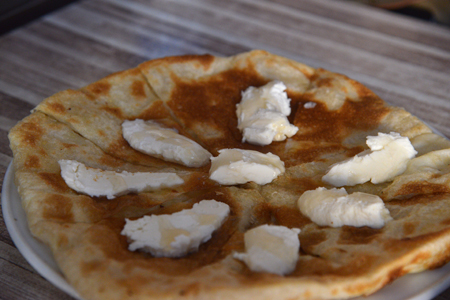21 Apr

Yesterday, my new best friend (I love making new best friends), Susan Hack, wrote up a post about our koshari meal at Abu Tareq in Cairo and other street foods I like and she rightly said that my favourite, together with koshari, is fiteer, so, I thought I would post about an amazingly good fiteer I had recently (sadly not with Susan) in Sayida Zeynab. I had seen and tasted almost eveything I wanted to in the two days I was in Cairo except for fiteer, so, I asked where was a good fatatri (fiteer maker) and was sent to one that did not look promising, dark and dingy and without any character but it was the only one and I decided to give it a try. And boy am I glad I did. Their fiteer was just perfect and even though I was going to lunch an hour later, I couldn’t resist eating far more than just the taste I had promised myself. I nearly finished the simple fiteer topped with eshta (Arabic clotted cream which in Cairo is made with buffalo milk) and honey in the top picture and had far too much of the fiteer mushaltat (several fiteers, one inside the other) in the picture below. Totally scrumptious.
17 Jul
[vimeo]http://www.vimeo.com/11170132[/vimeo]
When I was doing the research for my baking book, I kept coming across variations on the same breads throughout the Mediterranean, especially when it came to multi-layered breads. In some countries, the multiple layers are achieved by flattening the dough, folding it, then flattening it again (Moroccan r’ghayef, Tunisian mlawi or Algerian m’hajjib). In others, it is done by flapping the dough in the air to stretch it very thinly, then slapping it against a marble top and folding it (Egyptian fiteer or Turkish katmer), or it is achieved by rolling a disk of dough into a sausage, then squishing the sausage into a ring, and flattening the ring (Moroccan melwi).
Well, as you know I was recently in the Emirates, and while there I came across their own version of warqa which they call regag. They also have their own version of r’ghayef, called mukassab and their version of qatayef or beghrir which they confusingly call lgeimat (used normally to describe saffron-infused fritters drizzled with date syrup).
